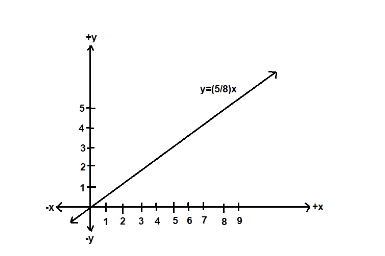
Draw a graph to convert miles to kilometres, given 1 mile = 1.6 km. Use the graph to find
(i) How many kilometres are approximately equal to 4.5 miles?
(ii) How many miles are approximately equal to 8 km?
Answer
488.1k+ views
Hint: We know that 1 mile is equal to 1.6 kilometres. Let the distance in kilometres be x and the distance in miles be y, then the relation between miles and kilometres will be
Complete step-by-step answer:
We are given to draw a graph to convert miles into kilometres and the value of one mile is equal to 1.6 kilometres.
The line equation when a slope and y-intercept are given is
Let the distance in kilometres be x and the distance in miles be y.
Then we can relate miles and kilometres as
Slope is
Now, substitute the slope in the line equation where the y-intercept is zero because when the distance is zero miles, the corresponding distance in kilometres is also zero.
Now using the line equation

When the value of y is 4.5 miles then the corresponding value of x in kilometers is
When the value x is 8 km then the corresponding value of y in miles is

7.2 kilometres is 4.5 miles and 5 miles is 8 kilometres.
So, the correct answer is “Option C”.
Note: The slope of a line can be obtained by the ratio of change in y-coordinates to the change in x-coordinates. Slope is a constant value but it has units. The units of slope will be the ratio of y-units to the x-units. Here, the units of slope are miles per kilometres. So do not assume that the slope will not have units. Do not confuse graphs with charts as a graph is a type of chart, but not vice-versa. All graphs are charts, but all charts need not be graphs.
Complete step-by-step answer:
We are given to draw a graph to convert miles into kilometres and the value of one mile is equal to 1.6 kilometres.
The line equation when a slope and y-intercept are given is
Let the distance in kilometres be x and the distance in miles be y.
Then we can relate miles and kilometres as
Slope is
Now, substitute the slope in the line equation where the y-intercept is zero because when the distance is zero miles, the corresponding distance in kilometres is also zero.
Now using the line equation

When the value of y is 4.5 miles then the corresponding value of x in kilometers is
When the value x is 8 km then the corresponding value of y in miles is

7.2 kilometres is 4.5 miles and 5 miles is 8 kilometres.
So, the correct answer is “Option C”.
Note: The slope of a line can be obtained by the ratio of change in y-coordinates to the change in x-coordinates. Slope is a constant value but it has units. The units of slope will be the ratio of y-units to the x-units. Here, the units of slope are miles per kilometres. So do not assume that the slope will not have units. Do not confuse graphs with charts as a graph is a type of chart, but not vice-versa. All graphs are charts, but all charts need not be graphs.
Latest Vedantu courses for you
Grade 10 | CBSE | SCHOOL | English
Vedantu 10 CBSE Pro Course - (2025-26)
School Full course for CBSE students
₹37,300 per year
Recently Updated Pages
Master Class 9 English: Engaging Questions & Answers for Success

Master Class 9 Science: Engaging Questions & Answers for Success

Master Class 9 Social Science: Engaging Questions & Answers for Success

Master Class 9 Maths: Engaging Questions & Answers for Success

Class 9 Question and Answer - Your Ultimate Solutions Guide

Express the following as a fraction and simplify a class 7 maths CBSE

Trending doubts
Fill the blanks with the suitable prepositions 1 The class 9 english CBSE

Difference Between Plant Cell and Animal Cell

Given that HCF 306 657 9 find the LCM 306 657 class 9 maths CBSE

The highest mountain peak in India is A Kanchenjunga class 9 social science CBSE

What is the difference between Atleast and Atmost in class 9 maths CBSE

What is pollution? How many types of pollution? Define it




